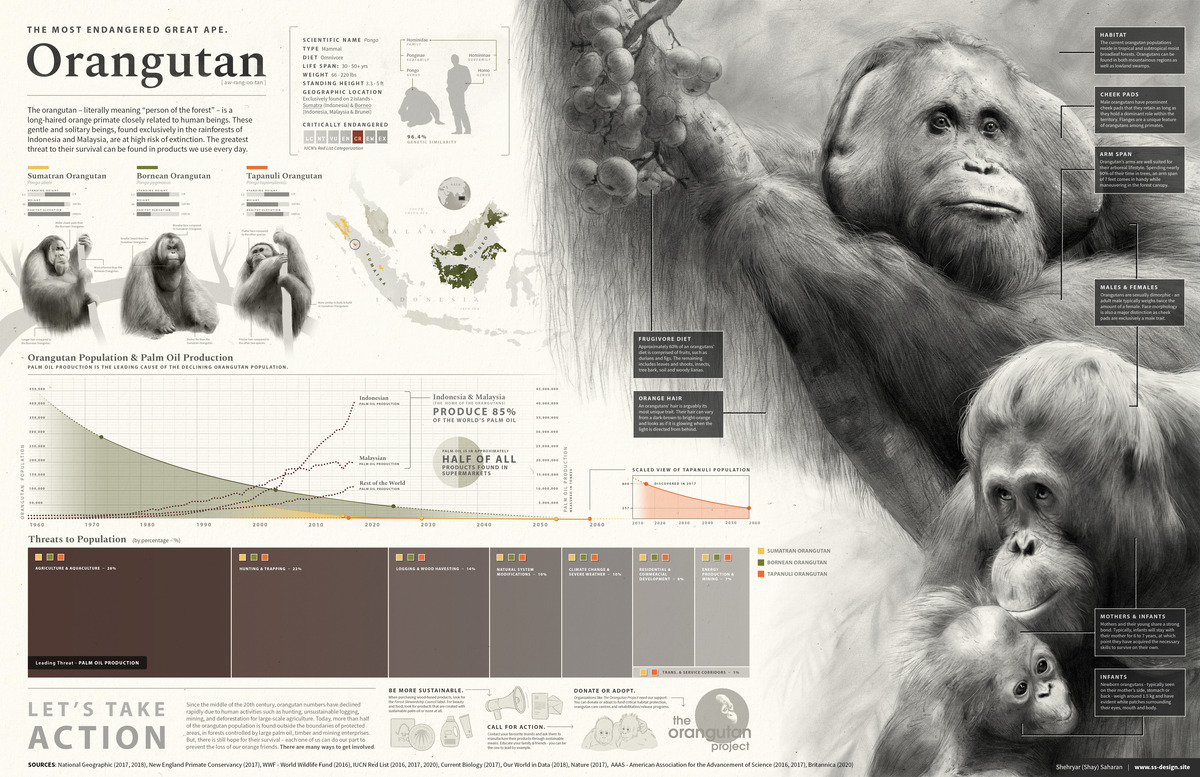
Click to view this graphic in a higher-resolution.
Orangutan: The Most Endangered Great Ape
Just 50 years ago, millions of our orange-haired relatives—the orangutans—populated Earth.
But over the past five decades, these numbers have declined by 50%, and orangutans are estimated to completely disappear in the next 50 years. Currently, the world’s most endangered great ape is on a path to extinction.
This illustrated graphic by Shehryar Saharan uses a wide range of information to highlight the threats that led to the downfall of the world’s orangutans, and what can be done to prevent their extinction. Sources include National Geographic, the New England Primate Conservancy, WWF, the IUCN Red List, Current Biology, Our World in Data, Nature, AAAS, and Britannica.
Where Are the Orangutans?
These long-haired, orange, and gentle primates are closely related to humans. They are extremely intelligent, and also crucial to the ecosystem as they help spread the seeds of trees in the forests they inhabit.
Found exclusively in the rainforests of Indonesia and Malaysia, these tree-dwellers are Asia’s only great apes. Their three species are all found on the islands of Sumatra and Borneo.
| Species | Scientific name | Location | Distinct Physical Features |
|---|---|---|---|
| Sumatran Orangutan | Pongo abelii | Sumatra (Indonesia) | Wide cheek pads, longer hair. |
| Bornean Orangutan | Pongo pygmaeus | Island of Borneo (Indonesia and Malaysia) | Small beard, broad face, dark fur. |
| Tapanuli Orangutan | Pongo tapanuliensis | Sumatra (Indonesia) | Flat face, Frizzy hair. |
Bornean Orangutans
The dark reddish-haired Bornean Orangutans are more likely than the others to come down from their trees and travel the ground in search of fruit. According to the IUCN, their population declined by over 50% in the past 40 years to a range of 55,000‒104,700, making it a critically endangered species.
Sumatran Orangutans
More social than their Bornean cousins, Sumatran Orangutans are often seen feasting on fig trees in large groups and don’t need to travel the ground. Historically distributed over the entire massive island of Sumatra and further south into Java, the species’ range is now restricted to the north of the big island.
Tapanuli Orangutan
Discovered in North Sumatra in 2017, the Tapanuli Orangutan is the newest-discovered great ape and the rarest one. With an estimated population of just 800 surviving individuals, these critically-endangered apes are teetering on the brink of extinction.
Threats
Like wildlife across the world, the orangutan population is threatened by factors like climate change, forest fires, and urbanization and development.
| Threats to Orangutans | Estimated Population Impacted |
|---|---|
| Agriculture and Aquaculture | 28% |
| Hunting and Trapping | 22% |
| Logging and Wood Harvesting | 14% |
| Natural System Modifications | 10% |
| Climate Change and Severe Weather | 10% |
| Residential and Commercial Development | 8% |
| Energy Production and Mining | 7% |
| Transport and Service Corridors | 1% |
However, the biggest drivers are the orangutan’s loss of habitat due to palm oil production, deforestation, as well as hunting and trapping.
Over the past 20 years, orangutans have lost over 80% of their habitat to deforestation for palm plantations, agriculture, mining, and infrastructure. One palm oil plantation can require thousands of hectares of tropical forests to be bulldozed.
Forced into a smaller areas with less food and shelter, the rest are in a constant game of hide and seek with hunters and poachers looking to capture them for food, artefacts, and the illegal pet trade of baby orangutans.
Our Role in Their Conservation
From lipsticks and body lotion to biofuels and wood, many items we use drive deforestation for their creation.
In the case of orangutans, avoiding items that use the very palm oil produced in plantations that destroy their habitats plays a big role.
On a larger scale, there are organizations like The Orangutan Project that are campaigning to end the deforestation of orangutan habitats and conserve the depleting population.
The post Visualizing Orangutans: The Most Endangered Great Ape appeared first on Visual Capitalist.